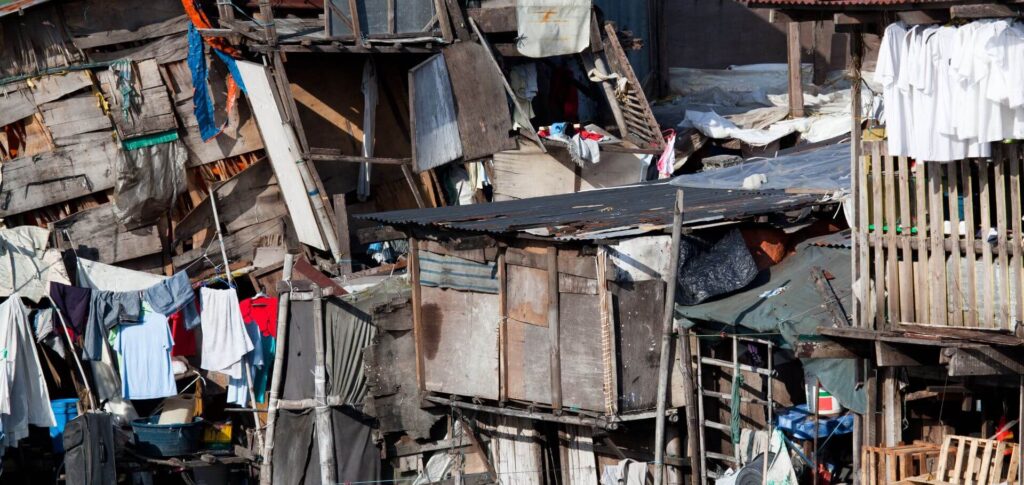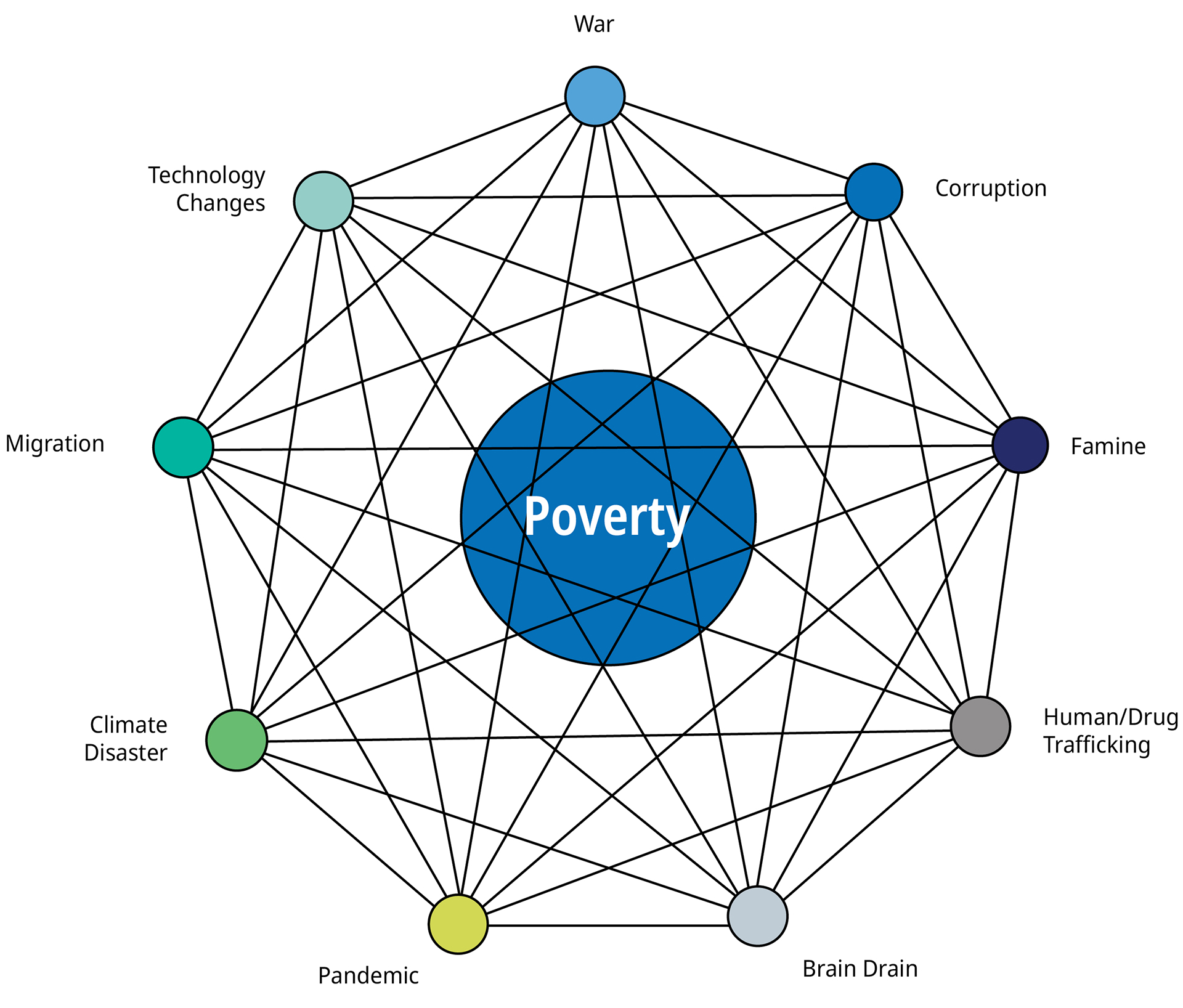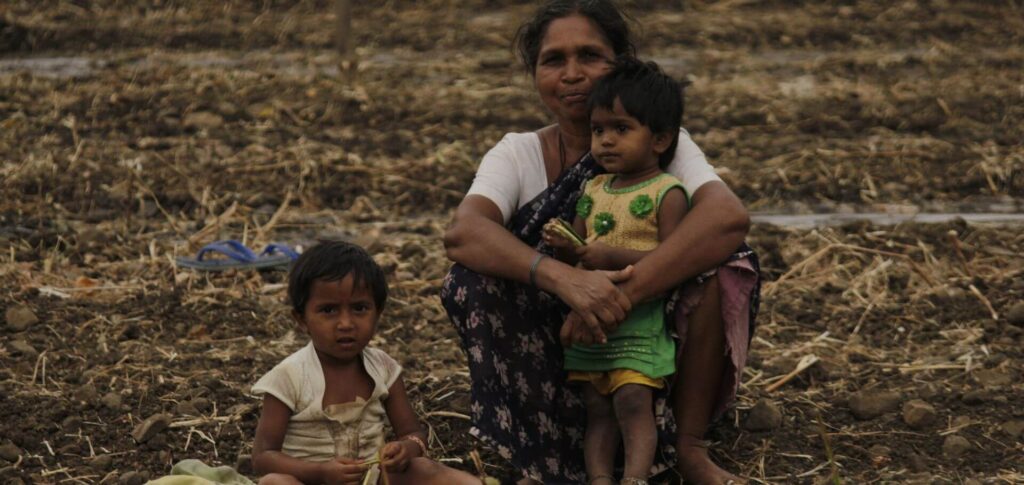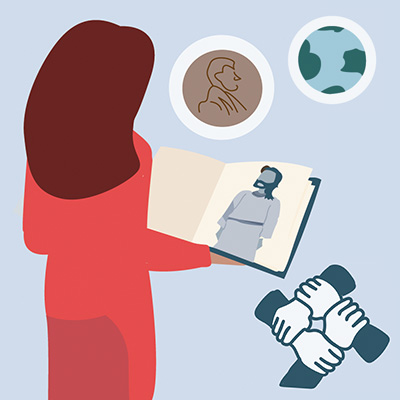Poverty and Access Gaps
Poverty: From Today to 2050
In 1948 the aspirational Universal Declaration of Human Rights was signed with great hope. It included statements about eradicating extreme poverty, and since that time, historic strides have been made in poverty reduction. Between 1829 and 2018 the prevalence of extreme poverty across the globe fell from 76 percent to 10 percent, but it has not been eliminated. Over 700 million people still live in extreme poverty, including one in five children.1
While we celebrate the strides made in poverty reduction, we must reckon with the reality that progress has apparently slowed between 2005 and 2021.2 The WB estimates that the COVID-19 pandemic intensified this problem by helping to push more than 70 million people worldwide into extreme poverty.3 MPI estimates that the pandemic will set poverty reduction back by three to ten years.4 This regression has been compounded by the effects of wars in Ukraine and Sudan and by China’s slowed economic growth. These global crises make the WB’s goal of reducing extreme poverty to less than 3 percent by 2030 seem out of reach.5

As Jesus Christ said, ‘You will always have the poor with you’ (Matthew 26:11). Not only has this been the case, but the definitions of poverty have changed over time, indicating an inability to accurately capture the contradiction of poverty existing in a world with enough for all. First, poverty was defined as living on USD 1/day (now increased to USD 1.90). Based on that number alone, the World Bank (WB) estimates in 2023 that 1 billion people live on less than USD 1/day (abject poverty), and 8 percent of the world’s population lives on USD 2.15 (extreme poverty).6
The measurement of poverty, while often measured by income, does not fully describe the multi-dimensional nature of poverty. Without adequate measurements for the multiple dimensions of poverty to help us understand its nature, we are less capable of implementing effective policies and interventions.7 Given the limitations of an income-based standard for poverty, development agencies are leaning toward indicators that measure more than one dimension of poverty. The Global Multidimensional Poverty Index (MPI) has been developed to provide a fuller picture of the complex dynamics of poverty so that more meaningful interventions can be developed. It consists of ten indicators that span health, education, and standard of living, revealing that a poor person in one part of the world is deprived differently than a poor person in another region. Moreover, it shows how one indicator can significantly impact other indicators to cause spiraling cycles of poverty.8 As important as it is to have this broader understanding of poverty’s causes and effects, work is still needed in understanding the integrative nature of poverty.
Maryann Broxton, ATD Fourth World USA, views poverty as a ‘lived experience’ and not just about ‘cause and consequence’.9 Therefore, we can posit that the church has an opportunity, even a mandate, to engage holistically in poverty’s human, lived issues.
Illustration 1: Interlinked Elements Driving Poverty’s Complexity

We must ask ourselves, ‘Is poverty an issue on God’s heart, and ought it therefore to be on ours? If so, what should we do? What is the church’s role given its assignments in Matthew 25 and the Great Commission?’
Examining The Complexities Of Poverty
Given the current state of poverty worldwide, we believe that future interventions to reduce poverty must include or at least analyze many additional factors currently used in the MPI, as shown in Illustration 1. Moreover, the complex interconnectedness of these causes of poverty must be taken into account.
- War: One of the most destructive man-made vices is war, which has immediate and long-term effects on its survivors. Amrita Rathi of the American Psychological Association advises that ‘death, injury, sexual violence, malnutrition, illness, and disability are some of the most threatening physical consequences of war, while post-traumatic stress disorder, depression, and anxiety are some of the emotional effects’.10
Additionally, wars in one country impact those living in other countries.11 UNICEF reports that the war in Ukraine and the resulting increase in food and energy prices means that children will be disproportionately disadvantaged and at greater risk of child marriage, trafficking, violence, exploitation, and abuse.12 Combined with persistent global inflation, this could result in a growing proportion of people experiencing poverty being priced out of access to basic needs, which, according to the World Economic Forum (2023), can fuel unrest and political instability.13
- Corruption: National-level corruption occurs when government officials use their authority for private gain in the designing and implementation of public policies.14 Corruption can occur in government, business, and other institutions originally designed to serve people. Lauryn Defreitas of the Borgen Project notes that corruption includes bribery, embezzlement, nepotism, and fraud and identifies ‘weak legal systems, bad governance, a lack of transparency, and poverty’ as key contributors to corruption.15 These structural failures negatively affect people’s lives by, among other things, reducing funding to alleviate poverty, reinforcing education inequalities, and misaligning investment in national infrastructure such as clean drinking water and housing.
- Famine: Oxfam (2023) defines famine as ‘the most serious food insecurity situation, in terms of scale and severity. [. . .] When more than 20 percent of households cannot eat, acute malnutrition exceeds 30 percent, and death and starvation are evident, we can no longer talk about a humanitarian ‘emergency’ situation but a famine.’16 As a part of Christ’s charge to the church, how can the church seek to mitigate famine and provide for millions in the throes of severe hunger?
- Human/drug trafficking: Human trafficking is compelled service for someone else’s profit.17 It typically has two primary forms: labor or sex. In the developed world, we can see examples of human trafficking around us in the faces of those who care for our elderly, work as maids, wash dishes in our restaurants, or do other types of manual labor.

Drug trafficking also contributes to poverty.18 Nick Croft of The Guardian aptly described this relationship: ‘Poor development fuels conflict, which fuels the drug trade, which fuels conflict, which fuels poverty.’19 Illegal drugs offer a lucrative job opportunity in a poor country with little opportunity. In this way, poverty and the drug trade become a life and death choice: sell drugs and have money for your family, or don’t sell drugs and die in poverty.
- Brain drain: The Cambridge Dictionary defines ‘brain drain’ as the situation in which many educated and skilled people leave their own country to live and work in another.20 For example, Mayanja, a Ugandan government economist, highlights that in Uganda, only 69 percent of healthcare jobs in 2015 could be filled, because many Ugandan-trained doctors migrated to countries with higher wages.21
Stark and Fan state that understanding the multiple effects of brain drain is crucial to resolving the issues. For instance, contrary to assumptions, many countries find that unemployment rate rises proportionately with the level of one’s education.22 There are simply no jobs for a highly educated person, showing the fallacy of measuring national education coverage rather than education that results in productivity, thus holistically reducing poverty.
- Pandemics: As noted above, the World Bank estimates that three to four years of progress was lost, as 97 million more people live on less than USD 1.90/day.23 The COVID-19 pandemic is one extreme example of issues that may occur again. UNICEF proposes a multifaceted process to tamp down potential pandemics, which includes improving healthcare overall by prioritizing trained healthcare workers; effective surveillance and response systems; building confidence in healthcare systems; vaccine programs; and strengthening logistics and supply.24
- Climate disasters: Natural disasters of all varieties are increasing. In analyzing the cost of disaster losses nationally, the United Nations Office for Disaster Risk Reduction reported in 2022 that even though richer countries have suffered the most extensive financial losses from disasters owing to their higher-value assets, poorer countries suffer much more significant losses than their economic wealth. This fact was exemplified in two of the most expensive disasters in 2022: Hurricane Ian caused 130 deaths and displaced 40,000 people in the USA, while floods in Pakistan caused direct damages estimated at more than USD 15 billion, killed more than 1,700 people, displaced 8 million people, and will cause long-term economic hardship.25
- Migration: People leave their country of origin for many reasons, including war, climate disasters, and lack of opportunity. The International Migration Report (2020) puts the situation in perspective by stating that 96.5 percent of people globally live in their country of birth, meaning that the other 3.5 percent are migrants.26 Migration affects not only those seeking a safer, better life, but also those countries overwhelmed by the cost of facilitating economically poor migrants.
- Technology changes: Rapid technology development has exacerbated the ‘digital divide’ between those with access to technology and those without. Initiatives like One Laptop per Child (OLPC) have attempted to reduce that divide.27 However, as with OLPC, many fail because they do not understand the supportive environment required to facilitate their success. Further, the increasing incorporation of artificial intelligence in every area of life will dramatically shift the marketplace landscape in years to come, reshuffling work opportunities in low income brackets, causing many to fall into poverty.
The United Nations maintains programs and processes to promote science, technology, and innovation across multiple platforms and countries.28 However, it is government-led and does not seem to include significant technology companies. Jeffrey Sachs outlines four hindering binds: ‘the lack of market demand, the tendency towards increasing returns to scale, the ecological barriers to diffusion of technology, and the human forcings which are probably doing disproportionate damage to the poor world’.29

Opportunities and Challenges for the Great Commission
Faced with the complexity of poverty, the church struggles to effectively execute its mission: to care for and make disciples of all mankind. As complex and grave as it may be, global poverty is not outside of the reach of our caring and creative God. The question is still before us: ‘Whom shall I send? And who will go for us?’ We believe that the church must rise up and work together in partnership, responding, ‘Here we are. Send us!’
What, we might ask, can the church do? What is Jesus’ challenge to us? With his parable of the talents in mind (Matt 25:14-30), we might consider, ‘What has he given us?’ Directly following this parable, Jesus confronts us with a scene of the heavenly throne room where the Son of Man divides the sheep from the goats. In welcoming the sheep, he says, ‘For I was hungry and you gave me something to eat, I was thirsty and you gave me something to drink, I was a stranger and you invited me in, I needed clothes and you clothed me, I was sick and you looked after me, I was in prison and you came to visit me’ (Matt 25:35-36). The actions Jesus honors are seemingly small things done with love and consistency.
If we believe that this matters to God, then it should matter to us. The next step is to discern how to act. How can we work together? What models are holistic and break through the complexity? To effectively address global poverty, we must understand its complexities and devise holistic solutions. In this unique time of assessing our progress, we would do well to:
- See the physical and spiritual as one.
As we read the gospels, we see Jesus’ commitment to the poor. While poverty will cause suffering for as long as we are in the world, Jesus leads us with many examples of his care for us. We all too often have separated the physical from the spiritual. We tend to view missions as primarily evangelism, imagining poverty reduction and social work to be lower priorities in God’s eyes. But that does not align with the image of Jesus in Scripture. He cared for the whole person—the outcast, the sick, the poor. A careful reading of Matthew 25:31-46 is sobering. His expectation is that his people will live lives characterized by compassion. Do we see our task as Jesus sees it?
When our fellow humans are in dire straits, and we do little to change the situation, our souls are also poor. We must repent and acknowledge that, as the people of God, we have not loved as God has loved.
- Close critical understanding gaps in the church.
We cannot solve a problem that we cannot see or understand. We must invest our time and resources into better understanding the dynamics of poverty both globally and in our own communities, and we must equip our members with this understanding. It can be hard to know where to start when trying to combat poverty in real-world communities, without bringing about negative unintended consequences. Promoting examples of fruitful and reproducible initiatives is invaluable in helping people move from theory to action. Notable examples of this include macro- and micro-business education30 and technology acceleration.31
- Create measures of success based on analytical models.
Contemporary analytical approaches, such as game theory, can help navigate the complexity of poverty allowing organizations to create measurable initiatives, communicate the need (example: reverse ‘doomsday clock’32), and demonstrate effective reduction of root causes and successful end results.
- ‘Creationize’ climate issues instead of politicizing them.
One of Lausanne’s contributions in this area is its Creation Care Issue Network, which brings together Christians from around the world. We must work together on the premise that ‘Stewardship of God’s creation (creation care) is a clear biblical command and an integral part of what it means to follow Jesus as Lord.’33 United in this calling, we can create technology and build awareness in a way that leads with biblical truth, not political alliances, and in this way we can mitigate climate-related causes of poverty.
- Collaborate to reduce redundancies and cross-purposes.
With the rapid development of new technologies, the church can develop timely, relevant information to support decision-making. This enables us not only to understand the crisis, but also to assess the best approach and identify our potential partners. A macro-organization such as Lausanne is well-positioned to gather and distribute valuable ideas and data in a timely way across national and denominational lines. Our efforts would also benefit from a secure, continually updated database identifying Christian organizations, their strengths, and capacities to facilitate partnerships that unite our shared mission.
As complex and grave as it may be, global poverty is not outside of the reach of our caring and creative God.
Our challenges are opportunities. Father God has created us to have a more significant impact in our world. The problems, as outlined above, have overwhelmed our global secular systems and seem unsolvable. However, none of this surprises God. He has created us for this moment in time. He cares for the smallest details and the larger picture. He searches for the lost sheep without neglecting the sparrow that falls. Complexity does not overwhelm Him. He placed us in this time and in each of our unique positions ‘for such a time as this’.
While this paper is not exhaustive, we hope that it serves the church well in living up to its mission. May this call inspire us, not overwhelm us. We hope that these connections can spur the church to find effective avenues for bringing God’s message of whole-person hope into the lived spaces of people in poverty.
Resources
- International Bulletin of Mission Research: Volume 47, Issue 2: Migration and World Christianity
- https://journals.sagepub.com/action/doSearch?AllField=poverty&SeriesKey=ibmd
- International Bulletin of Mission Research, Poverty. https://journals.sagepub.com/doi/10.1177/23969393221138343
- Mission Frontiers Magazine: Article by Steve Saint, son of Nate Saint, jungle pilot killed in 1956 by Waodani Indians (Aucas)
- http://www.missionfrontiers.org/issue/article/projecting-poverty-where-it-doesnt-exist
- Partnership Brokers Association: Excellent training, coaching, and consulting in multi-stakeholder collaboration www.partnershipbrokers.org
- World Relief: An excellent report on the effects of the pandemic and poverty, “COVID-19 Impact on the World’s Poor.” https://worldrelief.org/covid-report/.34
- Asmus, Barry and Grudem, Wayne. The Poverty of Nations: A Sustainable Solution (Wheaton, IL: Good News Publishers, 2013).
- Beisner, E. Calvin. Prosperity and Poverty, The Compassionate Use of Resources in a World of Scarcity (Eugene, OR: Wipf and Stock, 2001).
- Corbett, Steve and Fikkert, Brian. When Helping Hurts: How to Alleviate Poverty Without Hurting the Poor . . . and Yourself (Chicago: Moody Publishers, 2013).
- Fikkert, Brian and Mask, Russell. From Dependence to Dignity: How to Alleviate Poverty through Church-Centered Microfinance (Grand Rapids, MI: Zondervan, 2015).
- Hong, Yohan. A Theological Understanding of Power for Poverty Alleviation in the Philippines: With Special Reference to US-Based Filipino Protestants in Texas (Eugene, OR: Pickwick Publications, 2022).
- Kandler, Kurt and Bradsher, Bethany. If You Really Want to Help: Redefining the War on Poverty (Dubai: Kne Publishing, 2023).
- Kim, Micah. Missional Fidelity of MoveIn: An International Christian Mission Movement among the Unreached, Urban Poor (Eugene, OR: Pickwick Publications, 2023).
- King, David D. M. Reclaiming the Radical Economic Message of Luke (Eugene, OR: Pickwick Publications, 2022).
- Kresta, David E. Jesus on Main Street, Good News through Community Economic Development (Atlanta, GA: Cascade Books, 2021).
- Pattison, Bonnie L. Poverty in the Theology of John Calvin, Princeton Theological Monograph Series (Eugene, OR: Pickwick Publications, 2023).
- Platt, David. A Compassionate Call to Counterculture in a World of Poverty (Carol Stream, IL: Tyndale House, 2015).
- Plummer, Robert L. Editor. Rich in Good Deeds: A Biblical Response to Poverty by the Church and by Society (Faith & Work) (Dallas, TX: Fontes Press, 2022).
- Schirrmacher, Christine and Schirrmacher, Thomas. The Oppression of Women: Violence – Exploitation – Poverty, (Eugene, OR: Wipf and Stock, 2020).
- Walton, Steve (editor) and Swithinbank, Hannah (Editor).Poverty in the Early Church and Today: A Conversation (Edinburgh, Scotland: T&T Clark, 2019).
Endnotes
- “Ending Poverty.” The United Nations Global Issues. https://www.un.org/en/global-issues/ending-poverty.
- Ibid.
- “Poverty and Shared Prosperity 2022: Correcting Course.” World Bank Group (Washington D.C: World Bank, 2022). https://www.worldbank.org/en/publication/poverty-and-shared-prosperity. Accessed May 26, 2023.
- UNDP, OPHI. Global Multidimensional Poverty Index 2022: Unpacking deprivation bundles to reduce multidimensional poverty. (New York: 2022).
- “Poverty and Shared Prosperity 2022: Correcting Course.” World Bank Group (Washington D.C: World Bank, 2022). https://www.worldbank.org/en/publication/poverty-and-shared-prosperity. Accessed May 26, 2023.
- “Poverty and Inequality.” The World Bank. https://datatopics.worldbank.org/world-development-indicators/themes/poverty-and-inequality.html. Accessed April 29, 2023.
- “HLPF Side Event Considers How to Define Poverty with Those Left Furthest Behind.” SDG Knowledge Hub. https://sdg.iisd.org/news/hlpf-side-event-considers-how-to-define-poverty-with-those-left-furthest-behind/.
- UNDP, OPHI. Global Multidimensional Poverty Index 2022: Unpacking deprivation bundles to reduce multidimensional poverty. (New York: 2022).
- “HLPF Side Event Considers How to Define Poverty with Those Left Furthest Behind.” SDG Knowledge Hub. https://sdg.iisd.org/news/hlpf-side-event-considers-how-to-define-poverty-with-those-left-furthest-behind/. Accessed, May 1, 2023.
- Amrita Rathi. “Psychological Impact of Victims of War and Conflict.” APA at the United Nations. https://www.apa.org/international/united-nations/un-matters/rathi-war.pdf. Accessed May 10, 2023.
- “1 year on – the global impact of the war in Ukraine.” World Economic Forum. March 2, 2023. https://www.weforum.org/agenda/2023/03/ukraine-crisis-food-energy-poverty/.
- “The impact of the war in Ukraine and subsequent economic downturn on child poverty in Eastern Europe and Central Asia.” UNICEF Regional Brief. October 2022. https://www.unicef.org/eca/media/24706/file/The%20impact%20of%20the%20war%20in%20Ukraine%20and%20subsequent%20economic%20downturn%20on%20child%20poverty%20in%20eastern%20Europe%20and%20Central%20Asia.pdf.
- “1 year on – the global impact of the war in Ukraine.” World Economic Forum. March 2, 2023. https://www.weforum.org/agenda/2023/03/ukraine-crisis-food-energy-poverty/.
- S. Gupta, H. Davoodi, R. Alonso-Terme. “Does Corruption Affect Income Inequality and Poverty?” Economics of Governance 3, 23-45 (2002). https://link.springer.com/article/10.1007/s101010100039. Accessed May 1, 2023.
- L. Defreitas. “How Corruption in Developing Countries Impacts Poverty.” The Borgen Project, Blog. April 4, 2023. https://borgenproject.org/corruption-in-developing-countries/.
- “Hungry in a World of Plenty: Millions on the Brink of Famine.” Oxfam. https://www.oxfam.org/en/hungry-world-plenty-millions-brink-famine.
- “Global Report on Trafficking in Persons.” United Nations Office on Drugs and Crime. https://www.unodc.org/documents/Global_Report_on_TIP.pdf. Accessed May 1, 2023.
- Isabella Gonzalez Montilla. “The Link Between Drug Trafficking and Poverty.” The Borgen Project. https://borgenproject.org/drug-trafficking-and-poverty/. Accessed May 1, 2023
- Nick Crofts. “Drugs and development – caught in a vicious cycle.” The Guardian. April 7, 2011. https://www.theguardian.com/global-development/poverty-matters/2011/apr/07/drugs-development-caught-vicious-cycle-policy.
- “Brain drain.” Cambridge Dictionary. https://dictionary.cambridge.org/us/dictionary/english/brain-drain. Accessed May 26, 2023.
- R. S. “What educated people from poor countries make of the ‘brain drain’ argument.” The Economist. https://www.economist.com/open-future/2018/08/27/what-educated-people-from-poor-countries-make-of-the-brain-drain-argument? Accessed April 30, 2023.
- Oded Stark and C. Simon Fan. “Losses and Gains to Developing Countries from the Migration of Educated Workers: An Overview of Recent Research and New Reflections.” MIREM (Italy: European University Institute, 2007). https://cadmus.eui.eu/bitstream/handle/1814/7983/MIREM_AR_2007_02.pdf?sequence=1&isAllowed=y. Accessed May 1, 2023.
- Carolina Carolina Sánchez-Páramo, Ruth Hill, Daniel Gerszon Mahler, et al. “COVID-19 leaves a legacy of rising poverty and widening inequality.” World Bank. https://blogs.worldbank.org/developmenttalk/covid-19-leaves-legacy-rising-poverty-and-widening-inequality. Accessed May 25, 2023.
- “How to improve primary healthcare to prepare for pandemics.” UNICEF. https://www.unicef.org/stories/how-to-improve-primary-healthcare-to-prepare-for-pandemics. Accessed May 26, 2023.
- “The Invisible Toll of Disasters.” UNDRR. https://www.undrr.org/explainer/the-invisible-toll-of-disasters-2022. Accessed April 30, 2023.
- “World Migration Report 2020.” IOM UN Migration. (Geneva: International Organization for Migration, 2019).
- “One Laptop per Child.” Wikipedia. https://en.wikipedia.org/wiki/One_Laptop_per_Child. Accessed May 1, 2023.
- Carolina Carolina Sánchez-Páramo, Ruth Hill, Daniel Gerszon Mahler, et al. “COVID-19 leaves a legacy of rising poverty and widening inequality.” World Bank. https://blogs.worldbank.org/developmenttalk/covid-19-leaves-legacy-rising-poverty-and-widening-inequality. Accessed May 25, 2023.
- Jeffrey Sachs. “Science, Technology & Poverty: Five ways to mobilize development in low-income countries.” International Atomic Energy Agency Bulletin. https://www.iaea.org/sites/default/files/publications/magazines/bulletin/bull44-1/44105890710.pdf. Accessed, May 1, 2023.
- See Micro Business Center International for an example of this approach: https://mbcinternational.org/en/.
- See Bluefields Aceledora in Sao Paulo, Brazil for an example of this: https://bluefieldsdev.com.
- “2023 Doomsday Clock Announcement.” Bulletin of the Atomic Scientists. January 24, 2023. https://thebulletin.org/doomsday-clock/. Accessed May 13, 2023.
- “Creation Care Issue Network.” The Lausanne Movement. https://lausanne.org/networks/issues/creation-care.
- “COVID-19 Impact on the World’s Poor.” World Relief. March 15, 2022. https://worldrelief.org/covid-report/.





